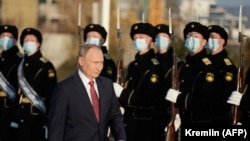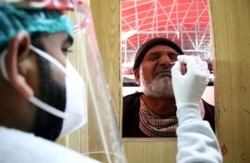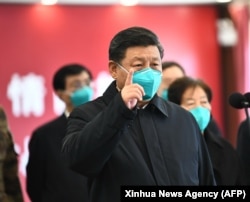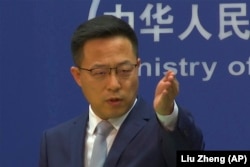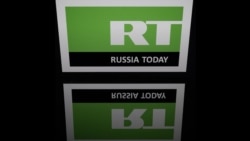China and Russia have pushed disinformation and propaganda about the origins of COVID-19, unproven cures for the disease, and the efficacy of vaccines aimed at winning over foreign audiences and sowing distrust toward Western governments since the emergence of the deadly virus in the Chinese city of Wuhan two years ago, a new study shows.
The strategies used by Chinese and Russian politicians and how their state media outlets carry out these campaigns is the focus of a new study from the Center for European Policy Analysis (CEPA) released on December 2.
The study found that while China and Russia have played a central role in spreading COVID-related disinformation and propaganda, they have followed largely separate strategies. It said, however, that the two countries have recently borrowed from and amplified each other’s campaigns.
RFE/RL's Coronavirus Coverage
Features and analysis, videos, and infographics explore how the COVID-19 pandemic is affecting the countries in our region.
While Beijing has mobilized its array of multilingual state media, social-media platforms, government officials, and online networks to try to convince the world that it should not be blamed for the pandemic and that China is the most effective global partner in combating the virus, Russian disinformation networks have largely sought to undermine faith in Western efforts to fight COVID-19 and exacerbate tensions, the study finds.
“Russia largely followed its preexisting playbook of using crises to inflame tensions in foreign societies,” the report states. “China borrowed some tools from Russia but used them for different ends, sanitizing its own record and spreading conspiracy theories on a global scale.”
While various governments and individuals from all across the world have helped boost disinformation related to vaccines and the origins of the virus, numerous studies and incidents have documented how China and Russia have played a leading role in amplifying politically expedient conspiracies already in circulation and spreading foreign disinformation about COVID-19’s origins.
The CEPA report aims to build upon previous studies and understand how the countries’ stepped-up efforts have evolved during the pandemic by compiling a 144,000-piece database to analyze articles and social-media messaging from Chinese and Russian government officials and state-backed media from March 2020 through March 2021.
“China selectively borrows from Russia’s playbook, but that has its limits,” Edward Lucas, a senior fellow at CEPA and one of the report’s authors, told RFE/RL. “China is trying to send out a message of self-confidence and push a consistent message about the [Communist Party’s] abilities, whereas the Russian campaigns are more focused on creating chaos regardless of whether it contradicts the Kremlin’s official version.”
A Disinformation Playbook?
Since 2016, Russia was been widely seen as the leading foreign actor spreading disinformation, for instance in efforts to influence important national elections.
With COVID-19, however, China took the lead globally, boosting its efforts to spread conspiracies about the origins of the virus and to polish its own image.
Chinese propaganda and disinformation have varied, from criticizing Western efforts to combat the virus to defending its own policies to curb the virus and promoting its efforts to supply countries with protective equipment and vaccines. While the CEPA report notes that Chinese narratives were “mostly positive, kept China at the center of attention, and showed remarkable consistency between state-backed outlets and diplomats,” there were notable exceptions.
In particular, China’s so-called Wolf Warrior diplomacy, where individual embassies and diplomats have taken to aggressively attacking Western policies and spreading conspiracy theories.
According to the report’s findings, these tactics from China accelerated after U.S. President Donald Trump and leading American conservatives floated the idea that COVID-19 may have escaped from a Chinese lab and grew more prominent again following a request by the administration of President Joe Biden that the U.S. intelligence community provide a more conclusive report on the possibility that the coronavirus leaked from a Wuhan lab.
In response, both Chinese state media and officials, including Chinese Foreign Ministry spokesman Zhao Lijian, stepped up efforts to spread conspiracies about the virus’s origins, including recirculating disinformation from early in the pandemic about Fort Detrick, a U.S. military lab in Maryland.
Fort Detrick has long been a focus of Russian disinformation campaigns, but Chinese efforts helped push it into a more mainstream discussion in China and across the West. In February, the AP published a nine-month investigation that found China had launched a global digital disinformation campaign, using its growing presence on Western social media to plant and spread stories implying that the United States created COVID-19 as a bioweapon.
Russian disinformation efforts, Lucas says, have been far more sporadic, from fostering doubts and misgivings about Western COVID-19 vaccines to defending the effectiveness of Sputnik V, Russia’s homegrown shot.
For example, social-media influencers in France and Germany reported in May that a London-based group controlled from Moscow offered to pay them to spread disinformation about the Pfizer-BioNTech vaccine. In another case, Russian state media and officials launched a campaign accusing Western media of being controlled by pharmaceutical corporations for what was deemed negative coverage around the trials of Sputnik V.
“As opposed to China, Russian disinformation is rarely about trying to make Russia look good to a foreign audience,” Lucas said. “It’s about exploiting disunity and polarization that already exists in the West, and this is something that Russian actors have fine-tuned over the years.”
Evolving Tactics
The CEPA report notes that Chinese and Russian efforts are constantly changing and may be entering a period of recalibration.
A Pew Research poll of mostly Western, developed countries published in June found that unfavorable views of China have reached new heights over the course of the pandemic and that Russian actors have changed some of their messaging as Russia has faced a sharp rise in COVID-19 infections and deaths and a widespread reluctance among Russians to get vaccinated.
But disinformation campaigns linked to both Beijing and Moscow continue.
Meta, the parent company of Facebook and Instagram, said on December 1 that it had removed more than 600 accounts linked to a Chinese influence operation that claimed the United States was pressuring the World Health Organization (WHO) to blame COVID on China.
Looking ahead, Lucas says that while there is limited evidence of explicit cooperation, China and Russia will continue to borrow tactics and amplify one another’s propaganda and disinformation campaigns.
One area to watch, he says, is a greater focus on developing countries, particularly across Africa, rather than in the West. China has been investing in its media operations across the continent for years and Russia has also begun to look to the region.
With the emergence of new variants of the coronavirus and a lack of access to vaccines in developing countries, Lucas says Africa is “fertile ground” for Chinese and Russian propaganda and disinformation.
“There is real resentment in parts of Africa and Asia about the slow global vaccination rollout and the West controlling access to vaccines,” Lucas said. “It’s a real problem, and when things are going bad somewhere, people are more willing to listen to messages and narratives coming from the outside.”




